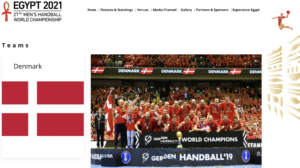Denmark won the 2021 IHF Men’s World Championship in handball this past Sunday in Egypt after an intense matchup, which ended with a victory of 26-24 against the neighbors from Sweden. This accomplishment marked the second consecutive world cup title for Denmark. The country, which also played a part in the invention of the game (Bonde, 2009), came into this year’s tournament as title holders from 2019.
Photo: Denmark – 2021 IHF Men’s World Champions.
Sweden surprised many experts by their strong play during the tournament while Denmark’s run to the title wasn’t necessarily a big surprise although vital experienced players weren’t available due to injuries. However, Denmark managed to take the title led by superstars such as goalkeeper Niklas Landin and playmaker[1] Mikkel Hansen.
In taking a sport management perspective, which reaches beyond the playing field, it is noteworthy to emphasize the symbolic meaning in how Øresundbron, i.e., the organization behind the Øresund Bridge, which acts as a 16-kilometre fixed link between Denmark and Sweden, activated the bridge in its attempt to tap into the huge interest and passion for handball in these two Scandinavian countries. As the tweet below illustrates, this was also an activation of the importance of the bridge in terms of shaping the relationship and infrastructure between the two neighboring countries, cf. the friendly neighboring relationship but yet intense rivalry on the playing field.
Stort tillykke til verdensmestrene fra Danmark! 🏆 Härligt med en nervkittlande final där länderna på båda sidorna av sundet kämpade om VM-guldet. Øresundsbron fejrer det flotte resultat med at lyse broen op i danske farver frem til midnat. #DetSomBinderOsSammen pic.twitter.com/SQYY6tW34v
— Øresundsbron (@oresundsbron) January 31, 2021
With the picture of the bridge in the colors of the Danish flag and under the hashtag #DetSomBinderOsSammen (‘what ties us together’ would be a quick and reasonable translation), Øresundsbron celebrates Denmark’s victory and portrays important building stones in Scandinavian societies such as the role of sports in relation to democratic values and sports as a community driver. As I have written with two co-authors in an article (Dave Almy & Frans Hammer), which will be published in 2021, the Scandinavian sports model is a reflection of the institutional pillars, which are integrated in how sports blend with the social responsibilities taken by Scandinavian societies, e.g., the accessibility to sports for all.
“Like the Bridge, sport is a connector, for fans and on big occasions for a nation. The handball championship for Denmark and Sweden is a recent example. The best example at the global level is the World Cup — when an entire country may turn from work and personal play to focus on the fortunes of their nation’s team.”
“In America, this weekend’s National Football League championship Super Bowl game (Sunday 7 Feb) serves an analogous role as a connecting focus of national attention. It attracts by far the largest TV audience of the year as both a live one-game competition in the #1 US sport as well as the premier site to see (and for most, actually watch) its commercials (over $5 million for 30 seconds of time). As a connector, it is a quasi-religious rite — engaging over two-third of US TV households watching TV during the four-hour program.”
Compared to elsewhere in the world where there has been a growing divide between neighboring countries and between various social groups, the above-mentioned tweet is a great celebration of more than Denmark’s handball title. This is a celebration of the positive social constitution and relationship between neighboring countries but sporting rivals. This is also a way to cherish how the Scandinavian sports model builds relationships between all groups of society across demographic, geographic, and psychographic differences, while placing positive impact on how sports can help to build bridges and social capital.
[1] Not playmaker in the sense of the position but rather manifested in his role on as a strategic cornerstone in Denmark’s offensive playing patterns and based on his individual star qualities, which has given him the label the best player in the world.
Reference:
Bonde, H. (2009). Epilogue: Globalization before globalization: Denmark sets a European fashion. The International Journal of the History of Sport, 26(10), 1571-1579.

COMMENTS
No comments yet.